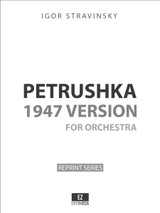
REPRINT SERIES
Perséphone (Persephone) is a musical work (mélodrame) for female narrator, tenor solo, mixed chorus, children's chorus, dancers and orchestra with music by Igor Stravinsky and a libretto by André Gide.
It was first performed under the direction of the composer at the Opéra in Paris, on 30 April 1934 in a double bill with the ballet Diane de Poitiers by Jacques Ibert. The premiere was staged by the ballet company of Ida Rubinstein, with Rubinstein herself dancing and speaking the part of Persephone and the tenor René Maison singing Eumolphe.
After his early “Russian” ballets The Firebird, Petrushka, and The Rite of Spring, all lavishly staged by Diaghilev’s Ballets Russes in pre-WWI Paris, Stravinsky began to experiment with “mixed” theatrical forms. In subsequent stage works, he upended traditional categories, juggling genres (dance, opera, oratorio, drama) like so many oranges. Renard (1916), a fanciful tale about four animals, bears the title “burlesque” and “is to be played by clowns, dancers, or acrobats, preferably on a trestle stage with the orchestra placed behind.” Histoire du soldat (1918), a dance-theater piece based on the Faust legend, is “to be read, played, and danced.” Stravinsky described the neo-classical Pulcinella (1920) as a ballet with song, or an action dansante, and the folk-inspired Les noces (1923) as “a divertissement of the masquerade type.” Oedipus Rex (1927), a massive concert setting of Sophocle’s tragedy, falls somewhere between oratorio and opera.
Perséphone is another ingenious hybrid. Written for the dancer/choreographer Ida Rubinstein and her troupe, it employs a female speaker in the role of Perséphone, a tenor as the narrator Eumolpus, a mixed chorus (splitting into various groups), a boy choir, and dancers. French writer Andre Gide (1869-1951) supplied the lyrical libretto, a revision of his long poem on the legend of the Greek corn goddess Demeter and her daughter, Persephone. The myth tells of Persephone’s abduction by Zeus’s brother Hades, who carries her off to the underworld. Demeter intercedes with Zeus to free Persephone, but she eats a pomegranate seed that dooms her to remain with the dead. Only when Demeter threatens to bring blight to the plant world does Hades agree to share Persephone with the living. Henceforth, Persephone spends winter in the underworld and the other seasons on earth.
In his poem and libretto, Gide recast the story. Most importantly, Perséphone chooses (by intentionally smelling a magic narcissus) to visit the underworld, because of her compassion for those doomed to dwell there, “a people without hope, pale, unquiet, and sorrowful.” For the staunchly Protestant Gide, Perséphone became a proto-Christ figure, a savior willing to make a sacrifice out of pity for those who suffer. Upon receiving the libretto’s first scene, Stravinsky wrote diplomatically to Gide that he aspired “to erect a very substantial monument in sound to go with yours.”
But their collaboration did not go well. Stravinsky strenuously objected to Gide’s suggestions about what sort of music should accompany his text. For Stravinsky, Gide’s words were nothing more than pieces of musical “material” subservient to the score’s metrical, rhythmic, and sonic demands – not religious or political messages to be carefully conveyed. At the first run-through, Stravinsky’s angular and fragmentary deconstruction of his text so offended Gide that he fled to Sicily.
Perséphone’s eclectic modernist music boasts impressive variety, color, and even some lovely tunes – a feature not usually associated with Stravinsky. The female chorus’ opening number, “Reste avec nous” (Stay with us) rises and falls with a seductive springtime languor. The score sounds more French than most of Stravinsky’s earlier works, with echoes of Gluck, Berlioz, Liszt, and Debussy. The flower chorus of the last tableau also refers (perhaps jokingly) to an unexpected Russian source, the “Song of the Volga Boatmen.”
At the glamorous premiere at the Paris Opera, the statuesque and imposing Ida Rubinstein took the title role, and Kurt Jooss supplied the choreography. Reviews were mixed, and Perséphone ran for only three performances. In later years, however, numerous choreographers have staged this oracular masterpiece, including George Balanchine at New York City Ballet in 1982.
- Difficulty:
- Advanced
- Instrumentation:
- 3Fl 1dPicc, 3Ob 1dCA, 3Cl 1dBCl, 3Bsn 1dCbsn, 4Hn, 3Tpt, 3Tbn, Tba, Timp, Perc, 2Hp, Pno, Strings
- Instrumentation (Cont.):
- Tenor, Female Narrator, Mixed Chorus, Children's Chorus
- Duration:
- 45 to 55 minutes
- Set of Parts:
- Includes Strings count 4.4.3.3.2
- Extra Strings, Chorus Score, Vocal Score:
- Only available with the purchase of the Set of Parts
- Product Type:
- REPRINT SERIES






